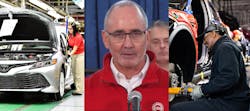What’s Next for the UAW? 5 Takeaways from Labor Experts
After a stand-up strike that stretched six weeks and cost Detroit 3 automakers billions in losses, United Auto Workers members are in the process of voting on four-year union contracts that promise more gains than they’ve seen in decades. But UAW leadership is not resting. UAW President Shawn Fain has declared that non-union automakers like Tesla and Toyota are next in the crosshairs.
IndustryWeek talked with two labor union experts on the UAW’s strategy, how the union landscape has changed and what employers should be thinking about as they map out plans.
We talked with:
- Stephen Silvia, labor relations professor at American University in Washington. He is the author of the 2023 book The UAW’s Southern Gamble: Organizing Workers at Foreign-Owned Vehicle Plants.
- Bob Bussel, emeritus professor of history and director of the University of Oregon’s Labor Education and Research Center from 2002-2022. Pre-academia, Bussel was a union organizer and representative for textile and farm workers.
Takeaway #1:
The UAW’s big wins with Ford, GM and Stellantis improve its chances of organizing workers at non-union automakers.
Organizing in the South has historically been very difficult, says Bussel, but the winds have changed. “The Big 3 contracts are Exhibit A,” he said. “They got something that really shows, ‘Here’s what a union and a group of organized workers can accomplish.’”
The UAW “can now point to sizable compensation gains that management would not otherwise have granted,” said Silvia.
Which Automaker Is Next?
Where might the UAW focus its resources next? Worker demographics, plant location and organizing history (or no history at all) all play a role in the union’s strategy.
Among the union’s best chances for initial wins, says Silvia, are plants with some history of organizing activity, like Volkswagen’s Chattanooga plant—which had a close race before—and “some of the older, foreign-owned facilities” such as Toyota’s Georgetown, Kentucky, plant.
“Older workforces in plants that no longer have a ‘new-car smell’ are potentially easier to organize,” he said.
VW has new plants under construction—its Scout plant and a battery plant in South Carolina—that may also be ripe for organizing, with a new, younger workforce that hypothetically has less loyalty toward its employer.
Bussel says you can bet the UAW is looking at the demographics of different plants as it’s deciding where to go next. He mentions two demographic areas where unions would have an edge:
- Plants with former UAW members. “That often tends to be an asset. People who have had experience either personally through working in a unionized plant, or through family members. You saw that at Amazon, certainly. They had family members [in a union], the union was something that people knew about.”
- Plants with younger workers, workers of color, more women. “Generally, I think the sensibilities that those workers have about power relationships and injustices sometimes recommend themselves as perhaps better places in which to try to organize.”
Bussel predicts that UAW workers from the Detroit 3 strike will be tapped as leaders in further organizing.
“I would assume that the UAW would be taking workers from these organized plants and have them be pretty heavily involved,” he said. “These workers have a very good story to tell, whether it’s going to be at suppliers or mainline auto plants.”
Takeaway #2:
Raising wages alone will not thwart the union.
Toyota recently announced that it would raise wages to levels comparable to pay in the new union contracts, and Honda said it is considering the same. This is fairly common practice among non-union automakers hoping to keep their workers happy and disinterested in unions.
But this time, matching hourly pay won’t necessarily “neutralize the boost that the UAW gets from the new contracts with the domestic producers,” Silvia said. “UAW organizers will [tell workers], ‘We got you a pay raise just through our successful negotiations with the domestic producers, but your pay is still below the full union rate. We can get you the full union rate if you vote for the union.’"
A recent Reuters article noted that under the old UAW contract, union workers’ total compensation package was $64 an hour, compared to $55 at non-union automakers. Tesla’s total compensation package is estimated at $45-$50 per hour.
The UAW can also argue that “if you don’t have things locked into a contract, the company can giveth and taketh away,” said Bussel. And “because of what we did with the Big 3, we can do much more—and not only with wages. We can begin to think about pensions, we can think about your tiers, we could think about COLAs [cost-of-living adjustments].
“You can accomplish all of this without a union. What could you accomplish with [a union]?”
A few years ago, Bussel toured auto plants in the South and was struck by their huge footprint, and thus influence, in smaller towns. But he thinks political influence and community influence outside of work will have less impact than in the past.
“The UAW has more assets at their disposal going into these types of campaigns,” Bussel said. “And some of the arguments that the employer or some of their political supports would make might not register as much, given everything that’s been going on.” Messages that the UAW is hammering home about record-breaking corporate profits and workers putting their lives on the line during COVID are minimizing employers’ arguments, he said.
Takeaway #3:
The UAW is gunning for Tesla.
“My sense is that Sean Fain seems like somebody that is swinging for the fences. He doesn’t just want to get a single, so to speak,” said Bussel.
Silvia notes several reasons that Tesla is vulnerable:
- Stock options have lost value. “At first Tesla was especially difficult to organize because the workers received stock options, which were quite lucrative because Tesla stock kept going up,” Silvia said. But those stock options peaked in 2021, and “have not done well since.”
- Tesla’s Inflation Reduction Act (IRA) subsidies could be at risk if it does not pay what’s considered a prevailing wage under the IRA. These subsidies from the Department of Energy go to electric vehicle manufacturers with a certain footprint in the U.S.
- The political and social landscape in California, where Tesla’s Fremont plant is based, leans heavily pro-union.
- Musk himself could become a rallying point for the union. “The biggest challenge that the UAW would face in trying to organize Tesla would be the resolute opposition of Elon Musk,” said Silvia. “But they could turn it to their advantage by making Musk—the ultimate tech bro billionaire—an issue. That said, the UAW will only win in any plant if it can convince a majority of employees that unionization brings higher compensation, more job security, greater plant safety and a bigger say in the workplace.”
Takeaway #4:
Momentum: The collective psyche is on labor’s side.
Two-thirds of Americans (67%) now say they approve of labor unions, a percentage that has steadily increased in the past decade.
Bussel sees Fain’s rhetoric in the stand-up strike having a long tail. “He framed the Big Three strike as the working class getting its fair share. That certainly appealed to UAW members, and I have a sense that’s resonating in other places as well.”
When non-union workers say they’re doing fine without a union, “now the UAW can say, ‘Well, hey, look at what we’re getting. And look at all the things we’ve been able to accomplish here,’” Bussel said. “I mean, other workers look at this and go, ‘Well, they did it. We can do it.’”
He adds, “I’ve always thought about organizing as a hope and fear dichotomy where management, usually a lot of their campaign is based on fear and the sense that you don’t know what could happen with the union,” he said. “The arguments don’t really change that much. I just don’t know that those arguments are having quite the same force. … I think the union has more credibility as far as talking about hope, and the employers perhaps have a little less credibility where they are, on the basis of fear.”
Takeaway #5:
Strike while the IRA is hot.
President Joe Biden walked the picket line with the union, but will his administration be voted out in 2024? Now is the time for the union to rack up some more wins.
With more labor-friendly policies than its Republican predecessor, the Biden administration, is “making it harder for companies to engage in illegal behavior that inhibits’ workers’ ability to organize. I think there’s a sense of the favorable circumstances there to take advantage of that,” said Bussel.
This is not quite the 1930s, where the unions said, “President Roosevelt wants you to join a union’ and it had some real force to it,” he qualified. “I’m not sure Biden’s presence has the same impact. But the fact he was out there supporting them … there are factors that are better than the union has had in recent years.”
Under Biden, as mentioned briefly above, the Department of Energy is drafting rules for automakers to qualify for electric vehicle subsidies under the Inflation Reduction Act. Those rules include compensation standards similar to those for regional prevailing wages in construction public works projects under the 1931 Davis-Bacon Act.
With pressure from the UAW, the DOE could deny non-union automakers electric-vehicle subsidies “by asserting that current compensation does not meet the standard set in the rule because it's not at the UAW contract rate,” said Silvia.
About the Author

Laura Putre
Senior Editor, IndustryWeek
As senior editor, Laura Putre works with IndustryWeek's editorial contributors and reports on leadership and the automotive industry as they relate to manufacturing. She joined IndustryWeek in 2015 as a staff writer covering workforce issues.
Prior to IndustryWeek, Laura reported on the healthcare industry and covered local news. She was the editor of the Chicago Journal and a staff writer for Cleveland Scene. Her national bylines include The Guardian, Slate, Pacific-Standard and The Root.
Laura was a National Press Foundation fellow in 2022.
Got a story idea? Reach out to Laura at [email protected]
